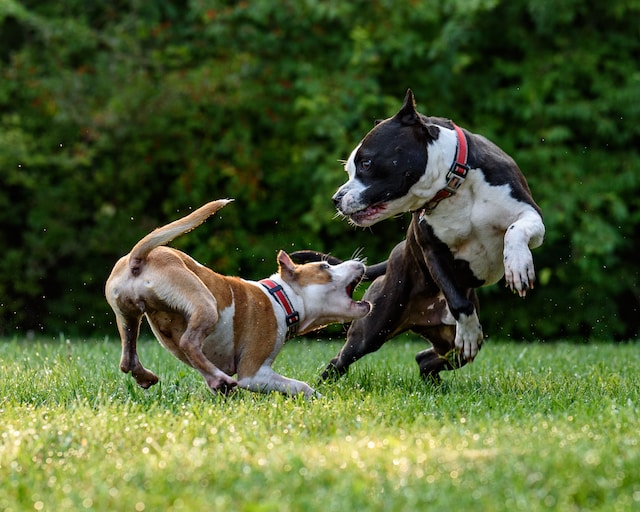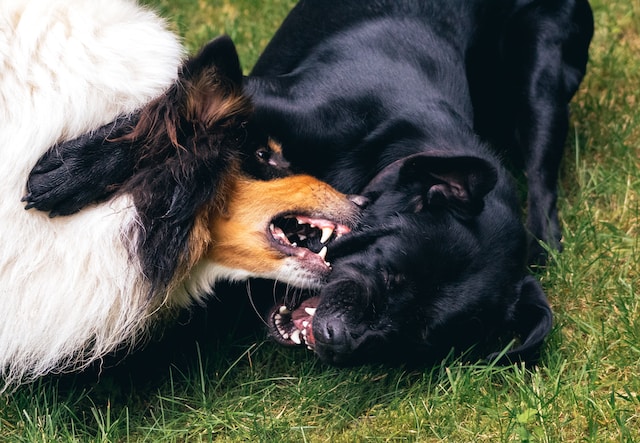Introduction – scary dogs
Dogs may be man’s best friend, but some dogs can look downright frightening! Have you ever encountered a big, intimidating-looking pup on the street that made your heart stop beating? Well, that isn’t unusual either; certain breeds of dogs are specifically designed to appear intimidating; this doesn’t indicate they’re dangerous though. In this article we’ll look into some startling facts about such breeds while exploring a few varieties which can often go misunderstood as frightening dogs.
Startling Facts about Scary Dogs
What Makes a Dog Look Scary?
Some dogs appear frightening due to their size, color or head structure. A large breed with an intimidating bark may make anyone nervous; black shades add an intimidating aura – but remember just because a dog seems scary doesn’t mean they actually are!
Many scary-looking dogs are actually big softies. They might look tough, but they’re often loving and gentle with their families. It’s all about how they’re raised and trained.
Some People Want Scary-Looking Dogs
Some folks get a dog that looks scary on purpose. They might want a dog that will keep strangers away from their house. But most of the time, these dogs are just regular pets that happen to look intimidating.
Purpose of the Article
Reason: Our intention in discussing scary-looking dogs is to demonstrate how appearances can be deceptive; just because a dog looks frightening doesn’t mean they are harmful or dangerous; we want you to see different varieties of such scary-looking pups so you can appreciate they can also be loving and friendly companions.

Types of Scary Dogs
Breeds Known for Their Fearsome Appearance
Big Dogs: Great Danes and Rottweilers are widely recognized for their fearsome appearance; they possess large frames with thick muscles. But these large canines tend to be gentle giants who enjoy being around people.
Black Dogs: Some studies show that black dogs look more intimidating. Breeds like Dobermans are often used as guard dogs, so people might think they’re scary. But color is just one part of what makes a dog look intimidating.
Dogs with Rough Barks: A dog’s bark can make it seem scary too. A loud, rough bark might make you think twice about approaching a dog, even if it’s just a big softy deep down.
Misunderstood Breeds – scary dogs
Pit Bulls: Pit Bulls are often seen as scary dogs, but they’re usually loving and friendly. They’re strong and have a certain look that some people find intimidating. But many Pit Bulls are great family pets.
Chihuahuas: Believe it or not, even small dogs such as Chihuahuas can sometimes appear intimidating. Their barking might make people uneasy; but oftentimes these pups are just trying to protect their family!
Don’t Judge a Dog by Its Looks
Keep this in mind when choosing your new best friend: don’t judge them by appearance alone. Even an intimidating-looking pup might turn out to be your favourite pet ever! And a cute, fluffy dog might have a mean streak. It’s all about how they’re raised, trained, and treated.
What Makes a Dog Scary
Dogs come in all shapes, sizes, and personalities. While most dogs are friendly and loving, some might appear scary to people. But what exactly makes a dog look or act scary? Let’s dive into the physical features and behavior that might give a dog a fearsome reputation.
Physical Features
Size: Big dogs often seem scarier simply because of their size. A large dog like a Great Dane or Mastiff can tower over people, making them feel small and vulnerable. But remember, size isn’t everything, and many big dogs are gentle giants.
Color: Some studies suggest that black dogs appear more intimidating. Breeds like Rottweilers and Dobermans, often used in guarding roles, might contribute to this perception. But color alone doesn’t define a dog’s personality.
Head Shape and Teeth: A dog with a blocky head and large teeth can look intimidating. When a dog bares its teeth and growls, it might seem threatening, even if it’s just trying to communicate.
Eyes: A dog’s eyes can also contribute to a scary appearance. Intense, staring eyes might make a dog seem aggressive or unpredictable.
Behavior and Temperament
Barking and Growling: A loud, rough bark or growl can make a dog seem scary. Some dogs bark to warn their owners of strangers, while others might bark because they’re excited or anxious.
Aggressive Behavior: If a dog shows signs of aggression, like snapping or lunging, it can be frightening. This behavior might be a reaction to fear or a way to protect its territory.
Body Language: Body language of dogs can provide us with insights into their emotional state. A dog who stands tall with its tail up and ears forward might be trying to assert dominance or authority over other members of its pack. This posture can seem scary, especially if the dog is also growling or barking.
Training and Socialization: An upbringing plays an enormous role in shaping a dog’s behavior. Canines who haven’t been as expected mingled may carry on in unforeseen or terrifying ways; with adoration, persistence, and preparing nonetheless, most canines can figure out how to act in manners that make everybody agreeable.
Myths and Misconceptions
Common Beliefs About Scary Dogs
Myth 1: All Big Dogs Are Dangerous – Many people think that big dogs are automatically dangerous. But size doesn’t determine a dog’s temperament. Many large breeds are known for being gentle and loving with their families.
Myth 2: Certain Breeds Are Always Aggressive – Some breeds, like Pit Bulls and Rottweilers, may be perceived as aggressive; however, their breed doesn’t define who they are; rather their upbringing, training, and treatment has more of an effect than any breed-related stereotypes could ever do.
Myth 3: Black Dogs Are More Intimidating – Color has no bearing on a dog’s behavior; while some might view black dogs as more intimidating than their counterparts, this perception does not correspond with reality.
Myth 4: Scary Looking Dogs Are Good Guard Dogs- Just because a dog looks scary doesn’t mean it will be a good guard dog. Guard dogs need specific training and temperament, not just an intimidating appearance.
Debunking Myths
Debunking Myth 1: Size Doesn’t Equal Danger – Many large dogs are well-known for being friendly with children and gentle when it comes to interactions between themselves and children, such as Great Danes which have earned the moniker of “gentle giants.” When selecting a canine companion it’s crucial that we pay attention to both its behavior and personality rather than simply considering its size alone.
Debunking Myth 2: Breed Doesn’t Define Behavior – Every dog is an individual. Though certain breeds might possess specific traits, that does not guarantee all members will behave similarly. Training and socialization play a greater role in shaping an animal’s behavior than breed.
Debunking Myth 3: Color Has Nothing to Do with Behavior- Black dogs can be as loving and affectionate as any other color, regardless of their fur color.
Debunking Myth 4: Training Makes a Guard Dog, Not Appearance- A good guard dog needs proper training and a suitable temperament. A scary-looking dog might deter some people, but without the right training, it might not act as a guard dog at all.
Training and Socialization
Importance of Proper Training – Training a dog is not just about commands; it’s about building a bond and understanding.
Understanding and Communication: Helps dogs and owners understand each other.
Safety: Ensures the dog responds to commands, keeping it safe.
Behavior Management: Helps correct unwanted behaviors.
Trust Building: Creates a secure and confident relationship between the dog and its owner.
Socialization Techniques- Socializing a dog means exposing it to new experiences.
Begin Early: Start socialization as soon as could really be expected.
Utilize Uplifting feedback: Reward appropriate conduct with treats or commendation.
Expose Gradually: Introduce new experiences slowly.
Include Different Experiences: Include various people, animals, and environments.
Join a Class: Consider professional training classes for structured learning.
Legal and Ethical Considerations
Laws Related to Specific Breeds- Understanding local laws is crucial, especially if they relate to specific breeds:
Breed-Specific Legislation (BSL): Some areas have restrictions or bans on certain breeds.
Licensing and Registration: Ensures dogs are vaccinated and tracked.
Leash Laws: Regulates when and where dogs must be leashed.
Understanding Local Laws: Always check local regulations, especially if considering a specific breed.
Ethical Treatment- Treating a dog ethically means providing for its needs and treating it with respect.
Providing Basic Needs: Ensure access to food, water, shelter, and medical care.
Proper Training and Socialization: Use positive methods for training and socializing.
Avoiding Neglect and Abuse: Treat dogs with compassion, avoiding harsh treatment.
Considering a Dog’s Well-Being: Think about the long-term commitment of owning a dog.
Personal Stories and Experiences
Interviews with Owners
Sarah and Her Rottweiler, Max: Sarah, a proud owner of a Rottweiler named Max, shares that Max is often misunderstood because of his appearance. “Individuals go across the road when they see us coming, yet Max is a close to home monster.. He loves playing with kids and is a big softy at heart.”
Tom and His Pit Bull, Bella: Tom’s Pit Bull, Bella, is a rescue dog. “Bella had an outstanding start to daily life, becoming my most-prized canine ever. She loves our family and plays nicely with other animals.” along with our cat. It’s all about how you raise them.”
Encounters with Scary Dogs
A Surprise Meeting with a Great Dane: While walking in the park, a young girl named Emily encountered a Great Dane. Initially frightened by its size, she soon realized the dog was friendly and gentle. They ended up playing together, and Emily learned not to judge a dog by its appearance.
An Unexpected Connection with a Doberman: John was initially wary of a Doberman on his route. One day, however, he decided to spend some time getting to know the dog, and they soon formed an incredible bond.”I understood he was simply safeguarding his home. Now we have a special bond, and he greets me with a wagging tail every day.”
Conclusion
Understanding and Sympathy: It means a lot to look past a canine’s actual appearance to figure out its actual person. Preparing and Socialization: Powerful preparation and socialization assumes a critical part in trim a little guy’s way of behaving.
Legitimate and Moral Contemplations: Monitoring regulations and treating canines morally are vital pieces of being a mindful proprietor.
Personal Connections: Personal stories and experiences show that scary-looking dogs can be loving and gentle.
As appearances can lead to snap judgments, it’s essential that we remember each dog is an individual. No matter whether it’s small and friendly breeds or larger and intimidating breeds, all deserve the opportunity to be understood and loved equally. Through empathy, compassion and responsible ownership we can create an accepting environment where every pup feels accepted and loved equally; let’s judge each one by their personality rather than its cover! After all, a dog loves unconditionally; our job as responsible owners lies in returning that love with kindness and understanding.
